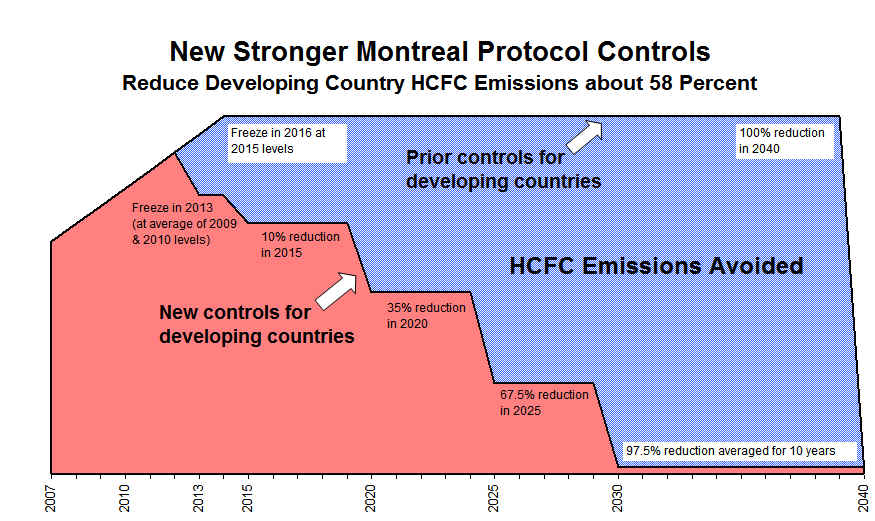|
All developed (i.e., non-Article 5) countries that are Parties to the Montreal Protocol are subject to caps on their consumption and production of hydrochlorofluorocarbons (HCFCs). Consumption is calculated by the following formula: consumption = production plus imports minus exports. The cap is set at 2.8% of that country's 1989 chlorofluorocarbon consumption + 100% of that country's 1989 HCFC consumption. The cap on production is set at the average of a) 1989 HCFC production + 2.8% of 1989 CFC production and b) 1989 HCFC consumption + 2.8% of 1989 CFC consumption. (Quantities of chemicals measured under the cap are ODP-weighted, which means that each chemical's relative contribution to ozone depletion is taken into account.) Under the Montreal Protocol, the U.S. and other developed nations are obligated to achieve a certain percentage of progress towards the total phaseout of HCFCs, by certain dates. These nations use the cap as a baseline to measure their progress towards achieving these percentage goals. The following table shows the U.S. schedule for phasing out its use of HCFCs in accordance with the terms of the Protocol. The Agency intends to meet the limits set under the Protocol by accelerating the phaseout of HCFC-141b, HCFC-142b and HCFC-22. These are the most damaging of the HCFCs. By eliminating these chemicals by the specified dates, the Agency believes that it will meet the requirements set by the Parties to the Protocol. The Agency is also committed to the phaseout of all HCFCs. The third and fourth columns of the table show how the U.S. will meet the international obligations described in the first two columns. The HCFCs to be phased out according to the schedule in the table below include HCFC-22, HCFC-123, HCFC-124, HCFC-133a, HCFC-141b, HCFC-142b, HCFC-225ca and HCFC-225cb.
¹ Adjustments to the HCFC phaseout schedule agreed at the 19th Meeting of the Parties to the Montreal Protocol, September 2007. ² The Parties agreed to address the possibilities or need for essential use exemptions, no later than 2015. ³ The Parties agreed to review in 2015 the need for the 0.5 per cent production or import for servicing during the period 2020-2030. Environmental Benefits of the New, Stronger HCFC Phaseout Agreement The agreement to adjust the phase-out schedule for HCFCs is expected to reduce emissions of HCFCs to the atmosphere by 47 percent, compared to the prior commitments under the treaty over the 30-year period of 2010 to 2040. For the developing countries, the agreement means there will be about a 58 percent reduction in HCFCs emission over the 30 year period. The HCFC reductions in developing countries, reflecting the agreement at the 19th Meeting in Montreal
The climate benefits of the stronger HCFC agreement will depend on technology choices of the transition from HCFCs during the 30 year time frame of the HCFC phase out. The estimated climate benefit of the new, stronger HCFC phase out may be as much as 9,000 million metric tons of carbon dioxide equivalent (MMTCO 2-eq), or the equivalent of removing the climate emissions from 70 million U.S. passenger cars each year, for the next 30 years. This means the new, stronger HCFC agreement is equivalent to eliminating the climate emissions from 50 percent of all U.S. passenger cars each year, for the next 30 years. Another way of explaining the climate benefit of the new, stronger HCFC phaseout agreement is to say it is equivalent to eliminating the climate emissions from the electricity needed by 40 million U.S. households each year, for the next 30 years, which would be eliminating the climate emissions from the electricity needed by 40 percent of U.S. households each year, for the next 30 years. Analysis – Overall HCFC Agreement |
||||||||||||||||||||||||||||




